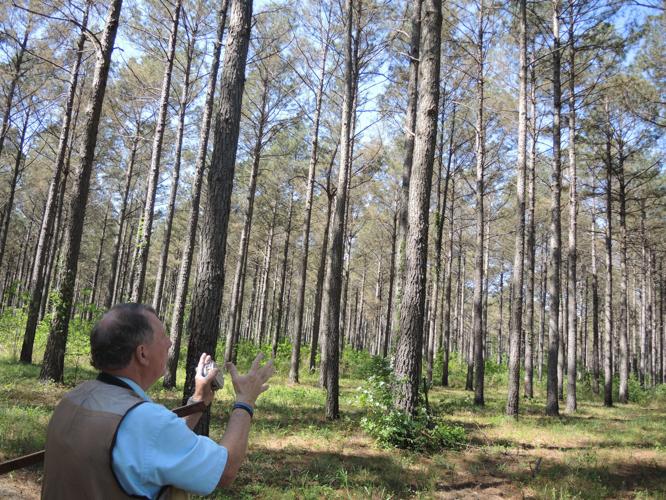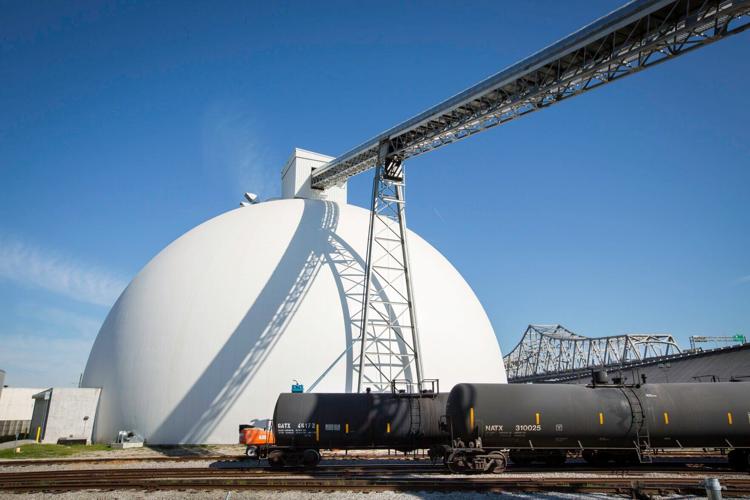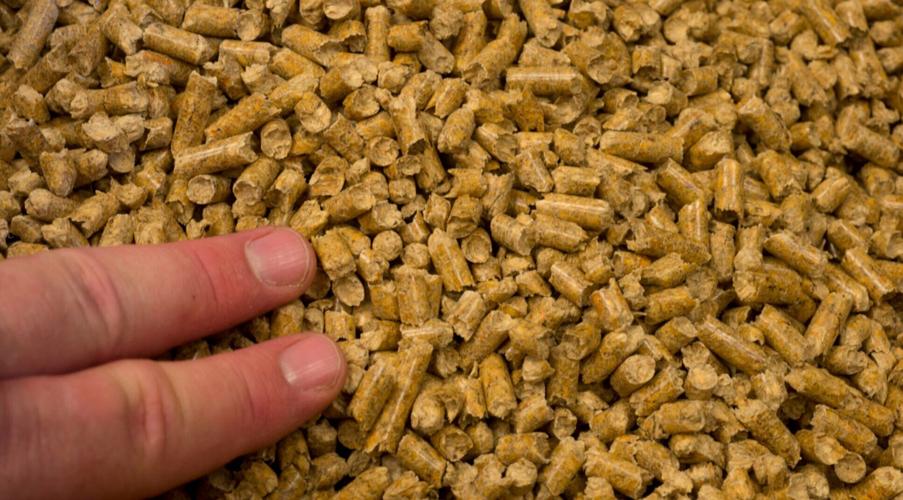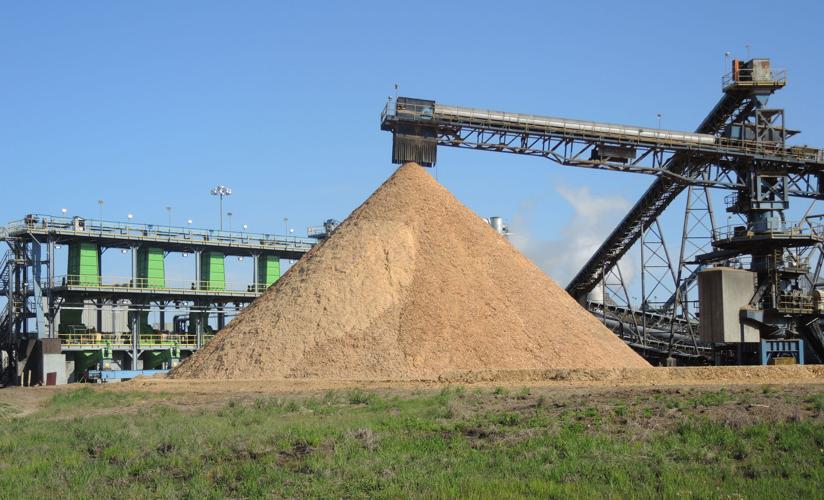Dr. Glen Melton gazes upon his towering row of green spires, a tract of conifer forest about 20 miles south of the Arkansas border. Fifty years after receiving a small plot of timberland from his uncle, the 73-year-old veterinary surgeon now owns more than 2,000 acres across northern Louisiana.
On a cloudless April day, he waxed on the merits of sustainable forestry, before giving a brief lesson on timber economics.
“Does money grow on trees?” he asked. The way he looks at it, yes — just in small increments over time, like any conservative investment.
In fact, the Louisiana forestry industry contributes more than $14 billion to the state’s economy each year, making it the largest agricultural sector. But lately margins have been thin, Melton said, and the once thriving timber market in his small town of Bastrop has shrunk to a handful of options.
“I hate to see timberland that's idle,” he said.
Now, a growing renewable energy industry offers a hopeful alternative for landowners like Melton. Attracted by vast swathes of privately owned forestland, bioenergy companies are building facilities in the South to manufacture wood pellets. Millions of tons of the biomass are then shipped to Europe and Asia, where they are burned for industrial-scale electricity.
In Louisiana — a state currently growing 70% more trees than it harvests — foresters see the new industry as a stabilizing force against volatile pulp and paper markets and a lifeline for shrinking rural communities.
“We have to keep the momentum going,” said Buck Vandersteen, executive director of the Louisiana Forestry Association. “This keeps people in rural areas. It keeps them closer to home … gives them good, high-paying jobs.”
Driven by European Union mandates to reduce greenhouse gasses linked to climate change, the value of Louisiana’s wood pellet exports have jumped from nearly nothing in 2018 to over $800 million in 2023, based on data from the LSU Agricultural Center.
Skeptics, including environmental advocacy groups, argue the energy is neither clean nor renewable, despite the industry marketing itself as such. They also say the subsidy-dependent industry won't survive once key policies in Europe expire as early as 2027.
Finding a market
About a 10-minute drive from Melton’s plot, logging trucks dump loads of sawdust, wood chippings and "roundwood", or young trees, at a wood pellet manufacturing facility in Morehouse Parish owned by the Drax Group. The company, based in the United Kingdom and publicly valued at more than $2 billion, owns seven such facilities in the South, including a similar operation in LaSalle Parish, and a dozen more in Canada.

Wood pellets flow into a Drax facility at the Port of Greater Baton Rouge. The wood pellets will be shipped to the United Kingdom for use as a fuel source for power plants.
Often dubbed by both critics and proponents as the “bottom feeders” of the forestry industry, Drax and most wood pellet manufacturers source much of their feedstock from the leftover residues of sawmills or forest cleanups that otherwise would go to waste. About half of the rest at Drax’s plants come from low-value roundwood from first thinnings — the fraction of trees in young forests that are cut down to reduce competition for nutrients and sunlight.
“Here, we’ve only got two viable markets for that first thinning,” said Melton, the timberland owner. “One is Drax, the other is a paper mill in Monroe.”
After the wood is dumped, conveyor belts transport it to a hammermill that beats it down to small, uniform chips, while a chipper strips intact logs of their bark. That bark is used to heat the chips at 1,800 degrees Fahrenheit in a giant rotating drum, drying the wood from its natural 50% moisture to around 10%. After more beating and rotating, rollers push the chips through pellet-sized holes like Play-Doh, creating a final product that resembles dog food.
The effort, said Brad Mayhew, vice president of the company's Southern operations, is to maximize the wood's caloric density.
“We’re trying to put as much energy as we can on the ship,” he said during a tour of the facility.
Environmental concerns
The process first drew scrutiny from environmental groups like EarthJustice in the 2010s, with Drax taking the worst of the flack.
In 2020, the company paid $2.5 million in fines for violations at its Gloster plant in Mississippi after testing revealed it released three times the legal threshold of a class of pollutants including carcinogens such as formaldehyde.

The Drax Power Station in Drax, England is Britain's largest power plant. The former coal plant now produces power by burning wood pellets produced at mills in Louisiana and Mississippi.
“They were basically lying through their teeth about what their emissions were,” said Patrick Anderson, an attorney who worked with the Environmental Integrity Project on the initial settlement cases against Drax. Soon, the predominantly Black town became a poster child for environmental racism after a Brown University health survey revealed widespread respiratory issues there.
In Louisiana, Drax paid $3.2 million in pollution-related settlements to the state for its two plants.
But proponents say the industry is improving its emissions-control technology, and Drax notes it self-reports third-party testing of emissions to the Louisiana Department of Environmental Quality.
“Do they hit road bumps from time to time? Absolutely,” Vandersteen said. “Since then, we have not heard anything negative.”
Drax has since installed additional thermal oxidizers to burn most of the exhaust but continues to exceed limits set by its air emission permits, including those for mercury and methane.
The state environmental department is considering whether to designate the company a "major source" under Louisiana's air toxics program, which would trigger stricter pollution controls for its pellet plants.
“We have ongoing permit update processes across our US operations, and we continue to work with regulators to ensure we have the most appropriate permits and operate compliantly,” said Michelli Martin, a spokeswoman for Drax.
Lifeline for Bastrop
At the center of Bastrop is a sporting goods store that doubles as a locally sourced burger joint. Over lunch, Melton is interrupted by just about everyone who walks through the door, a testament to the close-knit charm he says drew him back to rural Louisiana after graduating from LSU’s veterinary school in the 1970s.
“There’s good people everywhere, and there’s sorry people everywhere,” he said. The difference in Bastrop, he added, is that you can’t fake it.
Across the street is a vacant lot, the former site of an International Paper mill. When the facility shuttered in 2008, the town of nearly 12,000 suffered. After supplying wood to the pulp and paper industry for over a century, Bastrop soon saw rail lines fall silent, abandoned timber equipment littered across its roads and, since 2008, almost a quarter of its population leave.
“You can say we lost our tax base, lost 550 jobs, and yes we did,” Melton said. “But the biggest loss was our intellectual capital. We lost folks that were interested in running for political office, PTA, volunteering at the hospital. Those types of folks that are oftentimes the glue that holds the community together.”
“When you put everything into one company, and that company closes, it's devastating,” said Kay King, CEO of Morehouse Economic Development for the past 20 years. “We were scrambling to try to figure out what to do.”
With just over 80 employees and not using fully grown trees, Drax hasn’t filled the void left by International Paper, she said, but it has prevented a much worse exodus. The company contributes nearly $60 million to the parish’s GDP and sponsors local charities, festivals and literacy programs. Before Drax began construction in 2012, she said, the town’s rail line connecting Bastrop with the broader South was set to be dismantled as salvage by the Union Pacific Railroad.
“Drax saved that,” King said. “It's hard to really envision what a big impact this company had at a time when things were really bad.”
King says she is courting more sustainable-energy projects, as well as markets for mature trees.
“It’s just part of the start,” she said. “We are working hard to get a lumber mill here.”
Other alternative energy companies are being drawn by the state’s infrastructure and abundant wood waste. Louisiana Green Fuels announced plans to open a refinery in Caldwell Parish by 2026, producing up to 32 million gallons of diesel and naphtha annually from forestry byproducts, according to Louisiana Economic Development. Meanwhile, Beaver Lake Renewables is set to begin converting a former International Paper mill in Rapides Parish into a green methanol plant the same year, also using wood waste as feedstock.
A hazy future
Drax transports pellets from its Morehouse facility via rail to the Port of Greater Baton Rouge, where two white domes each store up to 40,000 metric tons of the material. The pellets then cross the Atlantic Ocean to a power station in North Yorkshire, England. There, the same type of combustion that powers trendy pellet grills from Home Depot generates approximately 5% of the UK’s electricity, making Drax the world’s largest wood burner.

Drax spent $30 million on two domes and other equipment and facilities to ship wood pellets out of the Port of Greater Baton Rouge.
Ember, a climate-focused energy think tank, reports that it is also the country’s largest source of carbon dioxide, despite receiving $717 million in clean energy subsidies in 2023.
Heather Hillaker of the Southern Environmental Law Center says European Union carbon rules only count emissions at U.S. harvest sites while ignoring combustion emissions in the U.K. — a system built on the false premise that replanted forests immediately offset emissions. This loophole, she argues, sustains a transoceanic supply chain by incentivizing companies to ship U.S.-harvested wood pellets to Europe, where their emissions go unaccounted for in energy-sector reports.
“We shouldn't be putting our public money into this industry at the expense of other industries," Hillaker said. “Especially if it's being done because of some climate change agenda.”
Amid claims that wood pellets actually emit more carbon than coal, some countries are beginning to change their policies. Drax’s existing subsidies in the UK are set to expire in 2027, but lawmakers agreed to keep funding a new bridge policy through at least 2030, citing the country’s energy security needs.
Last year Enviva, a U.S.-based firm and the world's largest wood pellet manufacturer, filed for bankruptcy, citing operational failures at their facilities and market uncertainties following the collapse of wood pellet prices. After restructuring, the company aims to launch a new Alabama mill sometime in May 2025.
“There is still a lot of life left,” said William Strauss, president and founder of FutureMetrics LLC, a leading consultancy in the wood pellet industry.
While the United States hasn’t shown much sign of using the energy option, European and Asian countries serious about climate change still see it as a viable way to stabilize grids when the sun doesn't shine and wind doesn’t blow, he said. His firm predicts global demand for wood pellets will grow by over 2 million metric tons annually through 2030.
The industry in its current form has a “clock ticking,” said Strauss, “but there is still a big future in somehow leveraging that material.”
Along those lines, part of Drax’s agreement for continuing its subsidies is to build a carbon sequestration facility at its UK power plant, in essence pumping and storing carbon dioxide deep underground — another promising, though controversial technology it claims wood pellets would power.
A role for forests
Back on his timber plot, Melton lazily dug his foot into the rich, loamy soil.
“A lot of parts of the country would die to have soil like this,” he said.
The southeastern U.S. produces more wood products than any other nation, accounting for 20% of the world’s pulp and paper. The Southern yellow pine he grows can take just 20 years to reach full size, faster than western U.S. species.
Trees are viewed as crops in places like Bastrop, and Menton says sustainability is baked into the business model: Cut too many trees and he is out of business.
“Sustainability, even though it's the buzzword in Europe, it's almost like it's a basic concept for us,” he said.
Melton hopes his kids and grandchildren will inherit his stewardship ethic along with the land.
But doubts linger whether forests will remain economically viable. Vandersteen's biggest fear is pessimistic landowners swapping timberland for shopping malls.
While the jury is still out about wood pellets, foresters see it as a hopeful start in reinventing one of humanity’s oldest renewable — and financial — partnerships.
“There will always be a role for forests to play,” Vandersteen said. “We just have to provide that incentive to keep those forests as forests.”








